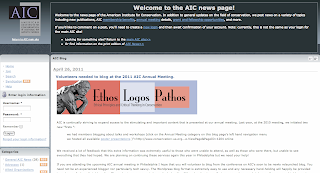This post by Jessica Ford is the first in a two part blog entry. Please check back for the second post by Katherine Langdon. Both Jessica and Katherine are pre-program interns working with Richard McCoy at the Indianapolis Museum of Art.
It’s been almost two months since Katherine and I embarked on our epic journey to visit conservation graduate schools: one that tested our navigational skills, our endurance, and our conservation aspirations. Having returned to the IMA in one piece with a strengthened determination towards our goals, I can say that the adventure was certainly a success.
Considering our daunting plan to visit all three East Coast graduate conservation programs (University of Delaware – Winterthur, NYU-IFA Conservation Center, and Buffalo State) in seven days, teamwork was a must

from the moment we loaded up my trusty Honda Fit with a week’s worth of personal belongings, snacks, and study material.
Our first stop was to visit the Winterthur/University of Delaware Program in Art Conservation’s (WUDPAC) annual Portfolio Day. Although we only got a taste of the breathtaking campus, we were assured that Winterthur was a fantastic place to be by Katherine’s book 1000 Places to See Before You Die. Two eager faces in the crowd of about 70 prospective students, Katherine and I were happy to have a chance to walk and talk for a moment with Professor of Material Culture and Adjunct Paintings Conservator Joyce Hill Stoner and converse in-depth with first-year student Crista Pack.
Second-year student Steven O’Banion gave our group an impressive and detailed review of his recent conservation opportunities. His presentation was followed by a whirlwind tour of the entire department. Pictures and more details of the event can be found on WUDPAC’s website.
From there we drove to the suburbs of Philadelphia, where we took lodging for a couple of nights (more on this stop in Part 2 of our story). Early on a dark Friday morning we set out again, this time by train to New York, New York. Katherine had never been to the Big Apple, and I had been once and loved it. Needless to say we were both quite excited for this excursion. The only challenge was smashing as much as possible into one day.
First, we hit the Conservation Center’s 50th Anniversary Celebration Open House. Located just a hop, skip, and a jump away from the Met, the building is in the tall, narrow, town-house style that one would expect uptown, which resulted in the different labs being neatly stacked on top of each other all the way up to the penthouse paintings lab. It was there that we met 3rd year student Kristin Robinson, who talked to us about the school and her experiences. The program in NYC is distinctly different from the other conservation grad programs in that the degree is actually a MA in Art History with an Advanced Certificate in Conservation. A strong interest in art history is part of what drew me to conservation in the first place, so I appreciate the emphasis. Kristin showed us a small, medieval icon that she was currently working on, which highlighted another benefit of the program – its proximity to the IFA’s prestigious art history program (right across the street). A Latin verse on the painting was illegible, but Kristin was able to find help from the Art History Department’s specialized faculty in puzzling together the correct phrase before restoring it.
In addition to the IFA, the number of important museums located nearby makes the location mind-blowing with respect to resources, art historically and otherwise. Some of the conservation curriculum takes place in the labs of the Met, MoMA, etc., and the network of connections built in this environment surely helps many students obtain 4th-year and post-graduate internships from these institutions as well. Plus, anyone who survives in NYC for three to four years automatically gains a fair amount of street cred.
After our visit to from the Conservation Center we headed to the MET, where objects conservator Beth Edelstein showed us where the conservation magic happens: a subterranean labyrinth of labs full of art objects – musical instruments, jewelry boxes, Islamic wall panels – and no less than 40 professionals to work on them. At one point, Katherine nearly had a heart attack when she spotted a very convincing replica of the Mask of Agamemnon. After Beth’s tour ended, our self-guided tour of the galleries began. After a couple of hours the rest of New York beckoned, and we filled the remainder of our afternoon and much of the night with the sights, sounds, and food of Midtown.
Saturday we were in Washington DC, where Katherine and I split up to cover as much museum ground as possible. While she investigated the Smithsonian’s National Museum of the American Indian, My husband Duncan and I trekked to the Museum of Unnatural History at a nearby Renaissance Faire.
This tale is only halfway done! Check back tomorrow to learn about the rest of our adventures from Katherine’s perspective including our time in Philadelphia, more about D.C., and our visit to the conservation program in Buffalo, New York.


 Don’t just head home when the sessions end at 5:30 p.m. on Friday, June 3. Stop by Mcgilli
Don’t just head home when the sessions end at 5:30 p.m. on Friday, June 3. Stop by Mcgilli

